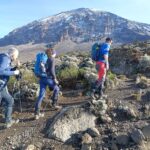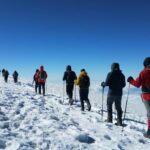Climbing Mount Kilimanjaro is a bucket-list adventure, but the risk of altitude sickness is a major concern for many trekkers. Standing at 5,895 meters (19,341 feet), Kilimanjaro’s peak is classified as “extreme altitude,” where symptoms of altitude sickness can occur if you ascend too quickly. This guide will provide essential tips for preventing altitude sickness and ensuring a safe and successful ascent to the roof of Africa.
Understanding Altitude Sickness
Altitude sickness, also known as Acute Mountain Sickness (AMS), is caused by the body’s inability to adjust to lower oxygen levels at high altitudes. Symptoms can range from mild to severe and typically include:
- Headaches
- Nausea or vomiting
- Shortness of breath
- Fatigue or dizziness
- Loss of appetite
- Trouble sleeping
More severe forms include High Altitude Cerebral Edema (HACE) and High Altitude Pulmonary Edema (HAPE), which require immediate descent and medical attention.
Top Tips to Prevent Altitude Sickness on Kilimanjaro
- Choose the Right Route
Selecting the right route is one of the most effective ways to minimize the risk of altitude sickness. Kilimanjaro has several routes, each offering different acclimatization opportunities. Longer routes provide a gradual ascent, allowing your body more time to adjust.
Best Routes for Acclimatization:
- Lemosho Route (7-9 days)
- Northern Circuit Route (8-10 days)
- Machame Route (6-7 days with acclimatization)
Avoid Shorter Routes: Shorter routes like the Marangu (5-6 days) increase the risk of altitude sickness due to rapid ascent.
- Go Slow: Follow the ‘Pole Pole’ Pace
In Swahili, “Pole Pole” means “slowly, slowly.” Going slow is key to acclimatizing properly. Walk at a relaxed pace, especially on the first few days of your climb, to give your body time to adjust to the thinning air.
- Tip: Resist the urge to speed up, even if you feel strong at lower altitudes. A slower pace helps prevent overexertion and allows your body to gradually adjust.
- Stay Hydrated
Dehydration can exacerbate symptoms of altitude sickness, so it’s important to drink plenty of fluids during your climb. Aim to drink 3-4 liters of water per day.
- Avoid Alcohol and Caffeine: Both can contribute to dehydration. Instead, stick to water, electrolyte drinks, and herbal teas.
- Hydration Tip: Carry a hydration bladder to sip water regularly without needing to stop.
- Eat High-Energy, Nutritious Foods
Proper nutrition fuels your body for the climb and supports acclimatization. Choose foods rich in complex carbohydrates, lean proteins, and healthy fats to keep your energy levels high.
- Foods to Pack: Oats, nuts, dried fruits, whole grain bars, and lean meats.
- Tip: Eat small, frequent meals to maintain energy and avoid nausea.
- Acclimatize Properly with ‘Climb High, Sleep Low’
Gradual acclimatization is critical to preventing altitude sickness. The “Climb High, Sleep Low” strategy involves climbing to a higher altitude during the day and then descending to a lower altitude to sleep.
- Plan Acclimatization Days: Some routes have built-in acclimatization days where you ascend higher but return to a lower camp to sleep.
- Tip: Consider taking an extra day on longer routes to acclimatize better.
- Consider Using Acclimatization Medication
Certain medications can help your body adapt to higher altitudes. The most common medication is Acetazolamide (Diamox), which stimulates breathing and helps acclimatize faster.
- Consult Your Doctor: Always consult with a healthcare provider before taking any altitude-related medications.
- Take Preventatively: Some climbers start taking Diamox a day or two before reaching higher altitudes.
- Listen to Your Body: Know When to Rest
Pay close attention to how your body feels throughout the climb. If you start experiencing symptoms of altitude sickness, inform your guide immediately and take action.
- Mild Symptoms: Rest, hydrate, and monitor yourself.
- Severe Symptoms: Descend to a lower altitude immediately—don’t wait.
- Sleep Well and Stay Warm
Sleep is crucial for acclimatization, so prioritize good rest. Staying warm helps conserve energy and avoids additional strain on your body.
- Invest in Quality Gear: Use a warm sleeping bag, proper base layers, and thermal clothing.
- Tip: Take a hot water bottle to bed for extra warmth on colder nights.
- Use Proper Breathing Techniques
Practicing deep, controlled breathing can improve oxygen intake at high altitudes. Try the rest step technique, where you pause briefly after each step, and practice breathing deeply in through the nose and out through the mouth.
- Breathing Exercise: Inhale deeply, filling your lungs fully, then exhale slowly and completely.
- Choose a Reputable Operator with Experienced Guides
Guides play a critical role in a safe and successful Kilimanjaro ascent. Choose a reputable operator with experienced guides trained in high-altitude climbing and first aid.
- Look for Safety Measures: Ensure your tour operator carries oxygen tanks, portable altitude chambers (PAC bags), and pulse oximeters to monitor oxygen levels.
- Personalized Attention: Guides who closely monitor your health and pace will better help you manage acclimatization and avoid altitude sickness.
What to Do If You Get Altitude Sickness on Kilimanjaro
If symptoms of altitude sickness arise, take the following steps:
- Communicate with Your Guide: Don’t ignore symptoms—your guide needs to know how you’re feeling to make informed decisions.
- Rest and Hydrate: Take a break, drink water, and see if symptoms improve.
- Descend if Necessary: If symptoms worsen or become severe, descend to a lower altitude immediately. Even a descent of 300 meters (1,000 feet) can make a significant difference.
- Use Supplemental Oxygen: In case of emergency, your guides should have access to supplemental oxygen or other emergency treatments.
FAQs on Preventing Altitude Sickness on Kilimanjaro
- Is altitude sickness common on Kilimanjaro?
Yes, due to the rapid ascent and extreme altitude, many climbers experience mild symptoms of altitude sickness. Proper acclimatization and slow ascent are key to reducing the risk.
- How can I improve my chances of avoiding altitude sickness?
Choose a longer route, go at a slow pace, stay hydrated, eat well, and consider taking medication like Diamox after consulting a doctor.
- Is Kilimanjaro harder to climb than other mountains due to altitude?
Kilimanjaro is a non-technical climb, but the altitude makes it challenging. The combination of rapid altitude gain and varied weather conditions contributes to its difficulty.
Climb Smart, Stay Safe
Preventing altitude sickness on Kilimanjaro requires careful planning, the right preparation, and listening to your body. By choosing the right route, acclimatizing properly, staying hydrated, and taking the climb at a steady pace, you can significantly increase your chances of reaching the summit safely. Remember, it’s not a race—getting to the top healthy and happy is the ultimate goal. Take the time to prepare and ensure your Kilimanjaro ascent is not only successful but also memorable and safe.







